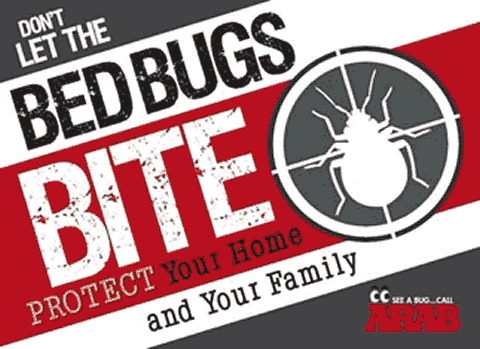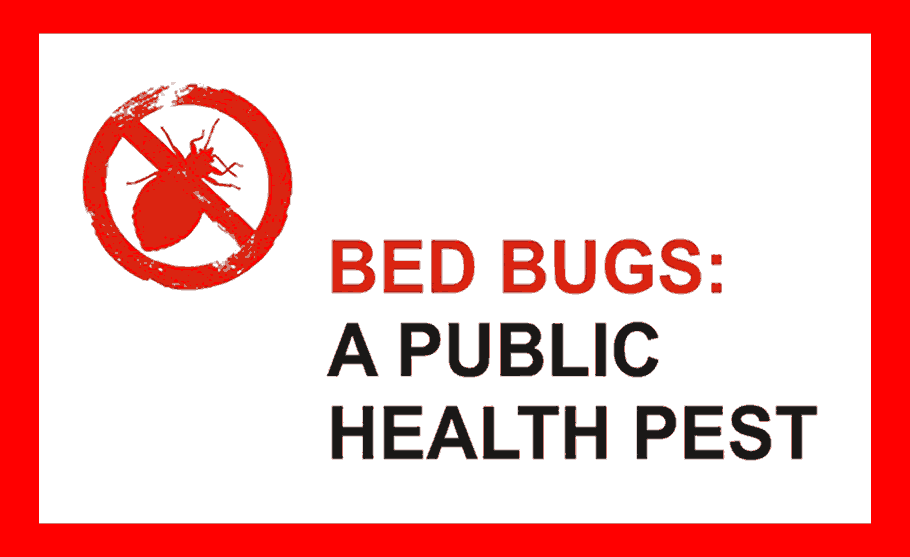Earwig
Information provided by Ohio State University.
Earwigs are a relatively small group of insect that belong to the Order Dermaptera. Earwigs often upset people when discovered indoors. Their forcep-like tail appendages make them look dangerous, but they are quite harmless. Earwigs run rapidly around baseboards, and they may emit a foul-smelling, yellowish-brown liquid from their scent glands when disturbed or crushed. Earwigs are mainly active at night, usually hiding during the daytime. They’re often found in clusters hiding in dark crevices like door or window frames. Earwigs normally live outdoors and do not establish themselves indoors, though the ringlegged earwig is a common resident in greenhouses. Earwigs are harmless to humans and animals, though if picked up and restrained, adult earwigs can give a slight pinch with the forceps. While mainly predaceous on other insects, earwigs often feed on flower petals, soft vegetables and fruits, or seedling plants when hot and dry conditions persist.
The name earwig actually comes from an Old English name, ēarewicga (meaning “ear insect”), which was derived from the superstition that earwigs can enter your ears at night and burrow into your brain to lay eggs. This belief is totally unfounded, though earwigs will occasionally seek out ear canals of campers as dark, moist hiding places. This can obviously be a traumatic experience!
Identification
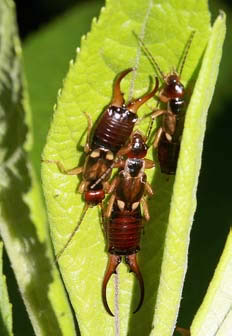 Adults of the European earwig are usually winged, while the ringlegged earwigs are wingless. If wings are present, the first pair are hard, short, and scale-like, while the second pair are membranous, fan‑shaped, and folded under the hard first pair of wings. Tips of the second pair of wings usually protrude from under the first pair. The European earwig ranges from 1/2 to 3/4 inch long, with banded legs and a reddish head. The ringlegged earwig ranges from 1/2 to 3/5 inch long and is black-yellowish underneath with legs having white crossbands at the joints.Young earwigs (nymphs) are similar to adults except that the nymphs lack wings and the cerci are short.
Adults of the European earwig are usually winged, while the ringlegged earwigs are wingless. If wings are present, the first pair are hard, short, and scale-like, while the second pair are membranous, fan‑shaped, and folded under the hard first pair of wings. Tips of the second pair of wings usually protrude from under the first pair. The European earwig ranges from 1/2 to 3/4 inch long, with banded legs and a reddish head. The ringlegged earwig ranges from 1/2 to 3/5 inch long and is black-yellowish underneath with legs having white crossbands at the joints.Young earwigs (nymphs) are similar to adults except that the nymphs lack wings and the cerci are short.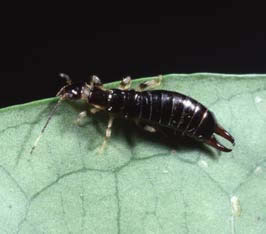
Life Cycle and Habits
Earwigs develop from egg to adult through gradual, or incomplete, metamorphosis with four to five nymphal instars. Generally, most earwigs lay eggs in late winter into early spring in chambers in the ground, under logs, or under stones. Usually, 20 to 50 smooth, oval, pearly-white or cream-colored eggs are produced. The female moves, cleans, and provides maternal care by protecting the eggs and new young until the first molt.
When spring weather is suitable, the female makes an opening to the soil surface where the young nymphs can leave the nest and forage for food. The small nymphs often return to their burrow during the day, but soon they are large enough to fend for themselves without a burrow. Earwigs are active at night and are often found around lights preying on other small insects that come to lights. During the day, earwigs hide in moist, shady places beneath stones, boards, sidewalks, and debris. They are rapid runners and feed on mosses, lichens, algae, fungi, insects, spiders, and mites, both dead and alive.
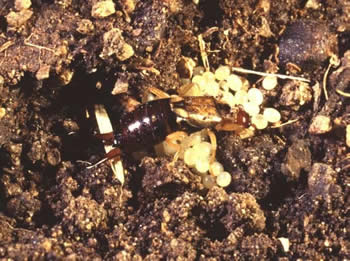 Earwigs rarely fly and are unable to crawl long distances, but they often hitchhike in laundry baskets, cut flowers, luggage, newspapers, lumber, baskets of fruits and vegetables, automobiles, etc. They prefer moisture and may migrate indoors during periods of prolonged heat and drought. Forceps at the end of the abdomen are used to defend the nest, capture prey, probe narrow crevices, and fold or unfold wings.
Earwigs rarely fly and are unable to crawl long distances, but they often hitchhike in laundry baskets, cut flowers, luggage, newspapers, lumber, baskets of fruits and vegetables, automobiles, etc. They prefer moisture and may migrate indoors during periods of prolonged heat and drought. Forceps at the end of the abdomen are used to defend the nest, capture prey, probe narrow crevices, and fold or unfold wings.
Earwigs require moist, cool places and are found in damp crawl spaces, in flower gardens near the home, in mulches, in compost piles, in trash, under boards, and in wood piles. After entering houses, they feed on sweet, oily or greasy foods or houseplants. They are attracted to lights.
Control Measures
If earwigs are persistently invading a home or building,
one should first attempt to control the earwigs outdoors. Since earwigs breed in soil chambers and spaces under landscape stones and timbers, reducing
mulch layers and landscape structures can help reduce populations. Since the European earwigs feed primarily on soft-bodied insects, use plants that are less prone to infestations of aphids and scales, or treat these insects when they are found.
During dry, hot weather, earwigs sometimes migrate indoors in search of cool and moist habitat. They are easily killed by residual insecticide treatments in cracks and crevices, along baseboards, beneath cabinets, along door and window sills, and in other hiding places during the day. Unfortunately, control will be short‑term due to new earwig entry from outdoors. Therefore, the best strategy is to better seal around doors and windows, which serve as the major entry points.
Prevention
Earwigs need and are very attracted to moisture. High populations, practically invisible during the day, may be present around foundations, in landscaped yards, in mulch, under boards, etc. Be sure to eliminate damp, moist conditions in crawl spaces under houses, around faucets, around air‑conditioning units, and along house foundations. Rain gutters and spouts should carry water away from the house foundation. Use caulking compound, putty, and weather stripping around doors, windows, pipes, and other entry sites, especially at the ground level. Change landscaping by creating a clean, dry border immediately around the foundation wall. Gravel or ornamental stones can make a barrier against earwigs and other pest invaders.
Trapping
Earwigs can be encouraged to cluster in trapping sites. Place burlap bags, canvass, boards, newspapers, or other cover material on top of mulch, around shrubbery, and on top of or around similar habitats. Earwigs will hide under these sheltered areas, where they can be collected early in the morning. Shake specimens into hot, boiling water or into a pan of soapy water. Indoors, remove with broom and dustpan
or by vacuum sweeper, but be sure to dispose of the vacuum sweeper bag to avoid having the earwigs crawl back out.
Insecticides
There are many insecticides labeled for earwig control.
Indoor treatments should supplement outdoor
Ohio State University Extension embraces human diversity and is committed to ensuring that all research and related educational programs are available to clientele on a nondiscriminatory basis without regard to race, color, religion, sex, age, national origin, sexual orientation, gender identity or expression, disability, or veteran status.
Contact Us ~ We can help!
Hours of operation: Monday through Friday 7:30 A.M. to 4:00 P.M. EST
Arab Pest Control, a division of Lewellen Services, Inc.
232 West Main St., Logan, OH 43138
800-654-8870
![]()
![]()


![]()
Serving Central And Southeastern Ohio Since 1980 • Family Owned And Operated• Fully Licensed By The State And Bonded And Insured. • Termite Warranties • Licensed Technicians • Extensive Training and Retraining• Uniformed Technicians• Marked Vehicles• All Pest Services Offered• Able To Tailor Services To Fit Your Needs• Convenient Hours• Polite And Courteous Staff • We Use The Up To Date Chemicals And Treatment Methods To Protect Your Family And Pets • Many Treatment Services Offered• Senior Citizen Discounts



